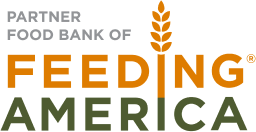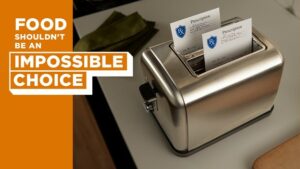Foodbanking facts and myths
Debunking some of the most common misconceptions about visiting pantries and easing the stigma around food assistance
By: Emily Gallion, Grants & Advocacy Manager and Caitlyn McIntosh, Development Manager
It can be intimidating to seek food assistance for the first time — but the experience doesn’t have to be scary. Last year, 935,404 total people received food through a Foodbank program. While we are aware of the stigma associated with visiting a pantry, our team is here to make the process as comfortable as possible.
Today, we will debunk some of the most common myths about hunger and visiting food pantries.
MYTH: A food bank is the same as a food pantry
FACT: Food banks serve as a central warehouse for a network of hunger relief organizations, including food pantries, soup kitchens, and emergency shelters. While some food banks may have an on-site food pantry, the two are not the same. Generally, a food bank is an organization responsible for acquiring and distributing food to smaller organizations, while food pantries provide groceries directly to families. The Foodbank acquires and distributes food to a network of 116 of these hunger relief agencies. Visit www.thefoodbankdayton.org/needfood to find one nearest you.
MYTH: You have to apply to receive food from The Foodbank
FACT: While some Foodbank programs, such as the Commodity Supplemental Food Program (CSFP), require an application, you do not need to submit an application to attend our Drive Thru Food Pantry. The only requirement to receive food at our Drive Thru or off site food distributions is a driver’s license (if available) and a verbal acknowledgement that your income is within the guidelines for receiving food. Typically, anyone living at or below 200% of the federal poverty limit is eligible to receive food from The Foodbank. During the COVID-19 pandemic, this threshold was lifted to 230%. To see if you meet the guidelines, click here.
MYTH: The Foodbank is primarily funded by tax dollars
FACT: Like most nonprofit organizations, the bulk of our funding comes from generous donations from the general public. While we receive agricultural surplus food from the USDA’s The Emergency Food Assistance Program (TEFAP), this product generally accounts for under 20% of the food we distribute.
MYTH: Everyone who visits a food pantry is unemployed
FACT: According to Feeding America’s most recent Hunger in America study, over half of households that visited a pantry or hot meal site had one or more members who were employed in the past 12 months. You do not need to be receiving unemployment or the Supplemental Nutrition Assistance Program (SNAP) to receive food from The Foodbank.
MYTH: We are the only place for you to get food in Dayton
FACT: The Foodbank provides food for a network of 116 partner agencies in Montgomery, Greene, and Preble counties. The Foodbank’s Drive Thru and Mobile Pantries are designed to supplement the hard work of these organizations. For that reason, the food you receive through these distributions may not be “complete” groceries, but will be bonus food to complement the food you receive from your local pantry. We encourage all of our clients to find their local pantry, which may have a greater variety of food on hand, at www.thefoodbankdayton.org/needfood.
MYTH: You can only visit The Foodbank once a month
FACT: The only service limit at The Foodbank is once per day. The Foodbank operates a Drive Thru pantry three days a week as well as 16 different mobile pantries each month. While each Foodbank agency has its own service limit, we invite our clients to use our services as often as needed, up to once per day. For a full list of drive thru hours and mobile pantry locations, click here.
MYTH: Food banks and food pantries really only provide canned goods — not fresh foods such as vegetables
FACT: All hunger relief organizations aim to provide nutritious foods to sustain a healthy life. A large majority of our food comes from retail donors, which means we receive a wide variety of items such as bakery, frozen meat, seafood, and lots of fresh produce. At The Foodbank we are also lucky enough to have a 75 raised bed urban garden that allows us to grow our own fresh produce and distribute it directly to the community.
MYTH: Families that receive the Supplemental Nutrition Assistance Program (SNAP) — aka food stamps — don’t need more help with groceries
FACT: The average monthly SNAP benefit for a one-person household was $131 in fiscal year 2020. SNAP provides supplemental assistance, but does not typically cover the cost of a family’s entire grocery budget. Many households need additional support to make ends meet.
MYTH: Fraud is widespread among SNAP recipients
FACT: According to the USDA, over 99% of people who receive SNAP benefits are eligible for the program. SNAP has low rates of abuse and provides critical support to our work. For every meal distributed by a Feeding America food bank, SNAP provides 12.
We are always working towards breaking the stigmas of seeking food assistance and ensuring that it is a comfortable, approachable process.
While we try to stay consistent, our service hours are subject to change, especially as the COVID-19 pandemic continues to evolve. For up-to-date information, double-check at www.thefoodbankdayton.org/needfood or follow us @thefoodbankinc on Facebook!





No comment yet, add your voice below!